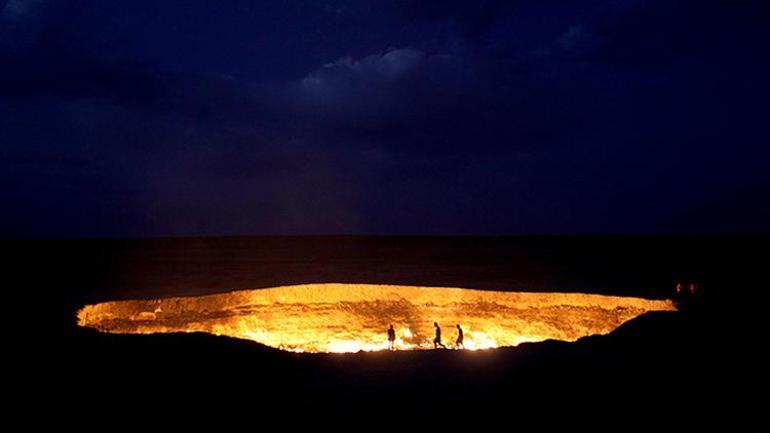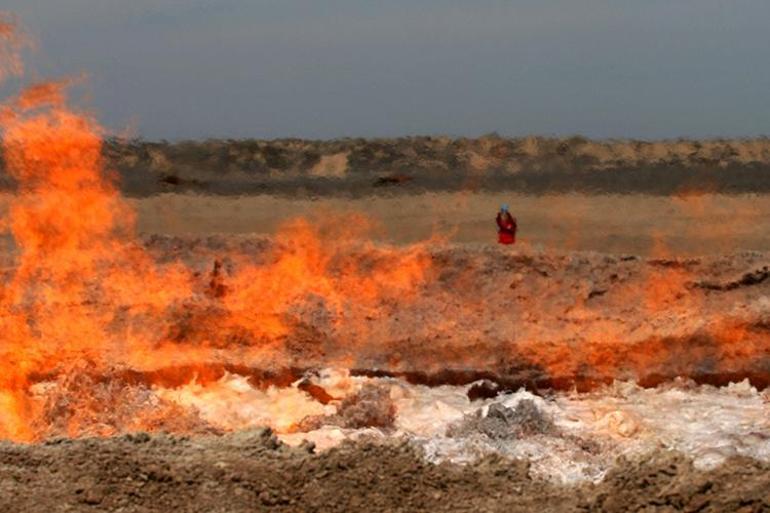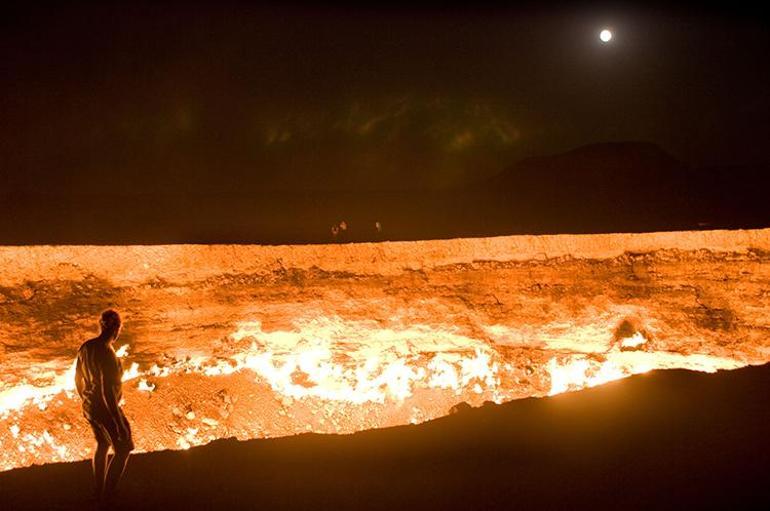Explorer George Kourounis achieved a first in 2013. Kourounis became the first person to enter the Derveze Crater located near the city of Ahal, 270 kilometres from Ashgabat, the capital of Turkmenistan.
Derveze Crater, which is a giant pit 70 metres wide and 30 metres deep in the middle of Karakum Desert, is also known as Derveze Pit or “Hell Gate”. Because the methane gas leaking from here has been burning continuously for about 50 years.
After 2 years of detailed preparations, Kourounis entered the crater and had only 17 minutes to take gas measurements and soil samples. Speaking to National Geographic, Kourounis said, “Those 17 minutes are etched deep in my brain. The inside of the crater was much more frightening, hot and big than I had imagined.”
Thanks to Kourounis’ expedition, Derveze Crater has become a global sensation. Photographs of flames and fabricated stories about the appearance of the pit, shared on social media, have turned the area into a major tourist destination.

‘THE RISK OF EXPLOSION WORRIES ME’
Turkmenistan, a country rich in oil and natural gas, has wells all over the country that produce methane gas, but none of them are as famous as Derveze. Recently, the Turkmenistan government has frequently raised the issue of shutting down all of these wells.
But putting out the flames is not that easy. To do it, three fundamental questions must first be answered: How did Derveze Crater form? What is the best way to close it? And most importantly, what would be the consequences of closing Derveze Crater?

‘THE EXISTENCE OF SUCH A CRATER SHOULD NOT SURPRISE US’
Contrary to the stories about it, Derveze Crater is actually not a very unusual formation. This pit, also called the “Light of Karakum”, is located in the Amuderya (Ceyhun) Basin, a geological region with endless oil and natural gas reserves.
Methane gas, the main component of natural gas, escapes through cracks in the earth’s crust. If this gas catches fire, it continues to burn until it runs out or is no longer in contact with oxygen.
“The existence of such a crater should not surprise us,” said Mark Ireland, an energy geoscientist from Newcastle University.
In the region, methane gases seeping from the earth’s crust often go unnoticed into the air or water. What makes Derveze Crater special is that it has been burning for almost half a century.
NO ONE KNOWS EXACTLY HOW IT CAME ABOUT
There are many stories about the appearance of the crater. No one knows which of these is true. However, most of the stories focus on the possibility of an industrial accident during the Cold War.
Accordingly, at some point between the 1960s and 1980s, while Soviet engineers were drilling for oil in the area, a crack appeared in the earth’s crust. This geological wound created a methane vortex.
The engineers probably tried to burn the gas to destroy it in a short time. Or the fire started accidentally when an engineer threw something like a cigarette butt into the pit.
Whatever happened, the result was a fire that burned unabated, spewing toxic pollutants into the environment. However, since the village closest to the pit was evacuated in 2004, there is no danger to the local population.

STEPS ARE BEING TAKEN TO REDUCE METHANE EMISSIONS
On the other hand, Hell Gate has become one of the most important touristic spots of Turkmenistan.
In recent years, however, there has been talk of extinguishing the fire in the pit and using the methane gas leaking from it for more appropriate purposes. This initiative is primarily driven by environmental concerns.
Methane is a very powerful greenhouse gas. Unlike carbon dioxide, which can remain in the atmosphere for centuries, it disappears from the atmosphere within a few years. However, since it causes much more warming than carbon dioxide, there are concerns that it may cause short-term and sharp shocks on climate conditions.
GAS LEAKAGE IS BAD BUT BURNING GAS IS GOOD
Many international agreements, such as the Global Methane Commitment, aim to reduce both anthropogenic methane emissions and natural methane emissions from marshes and melting permafrost.
Turkmenistan is one of the countries with the highest methane emissions. Leaking wells, pipelines and other industrial areas caused by unplanned mining activities carried out during the Soviet Union period are cited as the reason for this.
On the other hand, the gas from Derveze loses its importance when methane leaks are considered in general.
Guillermo Rein, a fire researcher at Imperial College London, told National Geographic, “It’s bad that there is a methane leak, but it’s good that this gas is burning.” “It’s good that it’s burning because a significant portion of methane is converted into carbon dioxide and water vapour in the combustion process. These are much weaker greenhouse gases compared to methane. In other words, in its current state, Derveze Crater is not a significant source of methane.
However, public interest in this area has drawn attention to the issue of methane emissions in Turkmenistan.
EASY TO PUT OUT FIRE, DIFFICULT TO STOP GAS
A two-stage operation is required to close the Derveze Crater. First, the fires will be extinguished, and then gas leakage from the earth’s crust will be prevented.
The first stage is easier to realise. For example, fast-drying cement can be poured into the crater, cutting off contact with the oxygen-rich air that fuels the fire. However, Ireland said that if this method, which he described as “putting a lid on it”, is applied, methane may find other ways to get to the surface, which could further increase methane release.
This means that in order to fully “seal” Hell’s Gate, the methane leak must be cut off at its source. “I don’t think anyone has a good idea of how this can be done,” Kourounis said.
LOCATION OF THE CRACK IS IMPORTANT
Emphasising that what is most critical at this point is to know what lies beneath the Derveze Crater, Rein also called for support for oil industry experts to locate the subsurface fracture from which the gas emerged.
If this place is found, it will be possible to fill the cement into the crack using underground pipes. “At the current state of oil and gas technology, it may be possible to plug the fracture if the location is known,” Rein said, adding that without this exploration work, no useful results can be obtained. Rein added that if exploration work is not carried out with extreme caution, a drilling accident could occur that could lead to an uncontrolled flare or a fatal explosion.
Mark Tingay, a petroleum geomechanics expert from the University of Adeleide, said that even if engineers could locate it, they did not know how to seal such an underground crack, “There is really no way to drill and plug it.” Pointing out that repairing industrial leaks is a complex process, Tingay said, “But geological leaks are much more chaotic and full of unknowns.”

THERE IS ANOTHER POSSIBILITY
Strange as it may sound, it is also possible to use a large explosive device to seal a methane leak. This method is used to extinguish industrial well fires. When the bomb, which is placed near the source of the leak through a borehole, explodes, the fire goes out as the oxygen is depleted. The rubble created by the explosion closes the crack that is the source of the leak.
However, it is not clear how well this method will work in Derveze Crater. Moreover, it would require a very large bomb. In the past, Soviet engineers used nuclear warheads to extinguish underground fires. However, this practice was discontinued in 1981 and it seems unlikely that something similar will be done again today.
Moreover, there is no evidence that this method would work in Derveze Crater. Kourounis said that even if the bomb is detonated, the gas could continue to leak from elsewhere. Many experts say that such an attempt could do more harm than good, and suggest that doing nothing may be the best option.
National Geographic’s “This ‘Gate to Hell’ has burned for decades. Will we ever shut it?“


